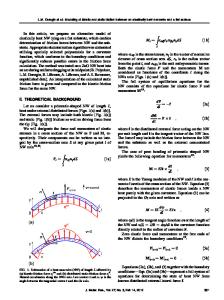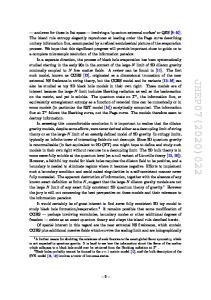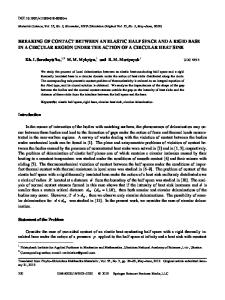Modeling the Contact Stiffness Between a 2D Voronoi Honeycomb and a Flat Rigid Surface
- PDF / 103,162 Bytes
- 6 Pages / 612 x 792 pts (letter) Page_size
- 2 Downloads / 339 Views
Q5.20.1
Modeling the Contact Stiffness Between a 2D Voronoi Honeycomb and a Flat Rigid Surface Richard D. Widdle, Jr.1, Thomas N. Farris2, Anil K. Bajaj1, and Patricia Davies1 1 School of Mechanical Engineering, Purdue University West Lafayette, IN 47907-2031, U.S.A. 2 School of Aeronautics and Astronautics, Purdue University West Lafayette, IN 47907-2023, U.S.A. ABSTRACT Open-cell foam can be thought of as a network of interconnected struts. To study the contact stiffness behavior, one can imagine the foam boundary to be characterized by struts that are free at one end, while the base-end is connected to the interior of the foam. In previous studies, the base-end was assumed to be built into a rigid surface, i.e., the surface struts were constrained to have zero displacement where they would connect to the foam interior. In this study the assumption that the surface elements are built-in is relaxed by modeling the elastic behavior of the foam interior. The foam interior is modeled as a network of struts within a finite element formulation. The analysis is simplified by considering two-dimensional honeycomb structures. It is found that including the foam interior in the model results in a significant reduction in the predicted contact stiffness. INTRODUCTION Cellular solids, or foams, are used in a wide variety of engineering applications [1]. To apply these materials effectively and efficiently, an understanding of their mechanical properties is required. Of interest in this study is the contact behavior of cellular solids. In particular, contact between open-cell foam and a flat rigid surface is considered. Open cell foams can be thought of as a network of interconnected struts. Struts at the boundary of the material would only be connected to the network at one end, while the other end is free. Fortes et al. [2] studied the behavior of contact between foam material and a rigid, flat surface. These investigators assumed the surface struts to be Euler-Bernoulli beams that are built-in at their bases Macroscopic or overall stress-strain relationships were derived by considering stretching and bending of the surface elements. In this paper the assumption that the surface elements are built-in is relaxed. The surface elements are modeled along with a portion of the foam interior, and investigated using finite element analysis. As a first step, and for computational expediency, the analysis is restricted to two-dimensional, or honeycomb, structures. The purpose of the study is to compare the finite element model with the model proposed by Fortes et al. As long as the material is assumed to be linear and elastic, and the struts can be modeled as Euler-Bernoulli beams, the results are independent material properties and the scale of the structure. MODELING Foams are typically formed by generating bubbles in a liquid medium. After nucleation the bubbles grow and pack together. When bubbles make contact with each other, a flat surface
Q5.20.2
defines the boundary between two neighboring bubbles. The bubbles then become
Data Loading...











